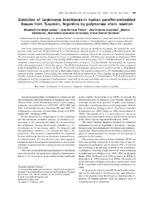Please use this identifier to cite or link to this item:
http://sgc.anlis.gob.ar/handle/123456789/248| DC Field | Value | Language |
|---|---|---|
| dc.contributor.author | Córdoba Lanús, Elizabeth | - |
| dc.contributor.author | Piñero, José Enrique | - |
| dc.contributor.author | González, Ana Cristina | - |
| dc.contributor.author | Valladares, Basilio | - |
| dc.contributor.author | Lizarralde de Grosso, Mercedes | - |
| dc.contributor.author | Salomón, Oscar Daniel | - |
| dc.date.accessioned | 2012-10-21T01:54:43Z | - |
| dc.date.available | 2012-10-21T01:54:43Z | - |
| dc.date.issued | 2005 | - |
| dc.identifier.issn | 0074-0276 | - |
| dc.identifier.uri | http://sgc.anlis.gob.ar/handle/123456789/248 | - |
| dc.identifier.uri | http://www.scielo.br/pdf/mioc/v100n2/v100n2a13.pdf | - |
| dc.description | American cutaneous leishmaniasis (ACL) is an endemic disease in Northern Argentina. We applied the polymerase chain reaction (PCR) followed by a hybridization labelled probe to 21 paraffin embedded human skin biopsies, already analyzed histologically, from leishmaniasis endemic areas in the province of Tucumán, Argentina. We used primers previously designed to detect a Leishmania-specific 120-base-pair fragment of kinetoplast DNA minicircle, other two primer pairs that amplify kDNA minicircles belonging to the L. braziliensisand L. mexicana complexes respectively, and specific oligonucleotide primers to detect L. (V.) braziliensiswhich amplify the sequence of the ribosomal protein L-14 of this species. The PCR-hybridization showed a sensitivity of 90.5% when compared to the histopathology test which was 61.9%. Five of the total samples analyzed were positive for the L. braziliensis complex whilst none was positive for the L. mexicanacomplex. The specific primers for L. (V.) braziliensisdetected the parasite in four samples. These results are consistent with those reported for close endemic areas and demonstrate that the causative agent of human leishmaniasis in the analyzed cases was L. (V.) braziliensis. PCR should be used as a diagnostic tool for tegumentary leishmaniasis, especially in the mucosal form, and as a valuable technique for the identification of the Leishmania species that causes the disease in certain areas. | en_US |
| dc.description | Fil: Córdoba Lanús, Elizabeth. Universidad Nacional de Tucumán. Instituto Superior de Entomología “Dr. Abraham Willink”; Argentina. | en_US |
| dc.description | Fil: Piñero, José Enrique. Universidad de La Laguna. Departamento de Parasitología; Argentina. | en_US |
| dc.description | Fil: González, Ana Cristina. Universidad de La Laguna. Departamento de Parasitología; Argentina. | en_US |
| dc.description | Fil: Valladares, Basilio. Universidad de La Laguna. Departamento de Parasitología; Argentina. | en_US |
| dc.description | Fil: Lizarralde de Grosso, Mercedes. Universidad Nacional de Tucumán. Instituto Superior de Entomología “Dr. Abraham Willink”; Argentina. | en_US |
| dc.description | Fil: Salomón, Oscar Daniel. ANLIS Dr.C.G.Malbrán. Centro Nacional de Diagnóstico e Investigación en Endemo-Epidemias; Argentina. | en_US |
| dc.format | application/pdf | ES |
| dc.language.iso | eng | en_US |
| dc.rights | info:eu-repo/semantics/openAccess | en_US |
| dc.source | Memórias do Instituto Oswaldo Cruz, 2005, 100(2), 187–192. | en_US |
| dc.subject | Leishmania braziliensis | en_US |
| dc.subject | Leishmaniasis Cutánea | en_US |
| dc.subject | Reacción en Cadena de la Polimerasa | en_US |
| dc.subject | Argentina | en_US |
| dc.subject | Tucumán | en_US |
| dc.title | Detection of Leishmania braziliensis in human paraffin-embedded tissues from Tucumán, Argentina by polymerase chain reaction | en_US |
| dc.type | Artículo | es |
| dc.coverage | ARG | en_US |
| dc.coverage | Tucumán | en_US |
| anlis.essnrd | 1 | es |
| item.grantfulltext | open | - |
| item.fulltext | With Fulltext | - |
| item.openairetype | Artículo | - |
| item.openairecristype | http://purl.org/coar/resource_type/c_18cf | - |
| item.languageiso639-1 | en | - |
| item.cerifentitytype | Publications | - |
| crisitem.author.dept | Administración Nacional de Laboratorios e Institutos de Salud “Dr. Carlos G. Malbrán” (ANLIS) | - |
| crisitem.author.dept | Instituto Nacional de Medicina Tropical (INMeT) | - |
| crisitem.author.parentorg | Administración Nacional de Laboratorios e Institutos de Salud “Dr. Carlos G. Malbrán” (ANLIS) | - |
| Appears in Collections: | snrd Publicaciones CeNDIE | |
Files in This Item:
| File | Description | Size | Format | |
|---|---|---|---|---|
| MemóriasdoInstitutoOswaldoCruz,2005,100(2),187–192.pdf | 52.21 kB | Adobe PDF |  View/Open |
Page view(s)
220
checked on Dec 17, 2025
Download(s)
111
checked on Dec 17, 2025
Google ScholarTM
Check
Items in DSpace are protected by copyright, with all rights reserved, unless otherwise indicated.

